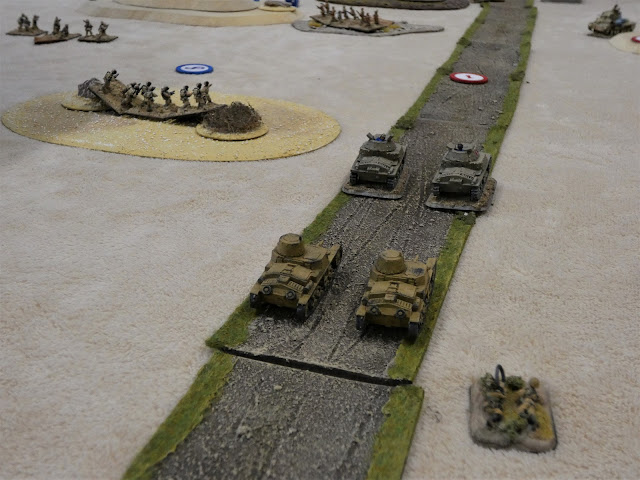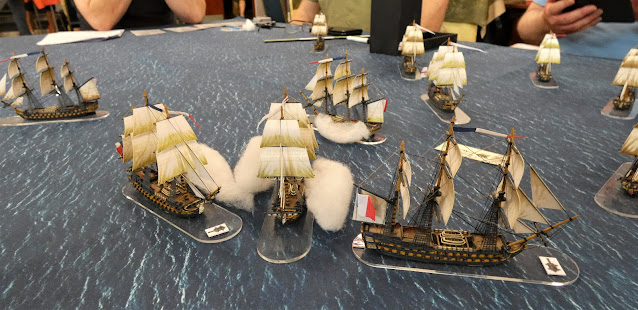 |
| Beda Fomm - Brian Sanders |
My third foray into the desert again saw three out of the four players with limited/to no knowledge
of O-Group. Putting on three games in the first half of the year is a bit of a first for me, but there’s no better way to get to know the rules.
 |
| Map illustrating the retreat of Italian forces along the coast route in the Western Desert and the inland route of the Empire blocking force that would cut off their retreat at Beda Fomm |
This time I used the desert scenario from the author, Dave Brown, based on the battle of Beda Fomm in 1941, published in the latest Lardy Magazine.
 |
| https://toofatlardies.co.uk/product/lard-magazine-2022/ |
This pitted a large, retreating Italian force from their 10th Army, trying to force its way through a smaller, British blocking force, called Combeforce, named after its commander Lt Col John Combe.
 |
| The map was mistakenly left out of the magazine article and subsequently published on the Lardy Forum and reproduced here should you wish to give the scenario a go. |
Stephen & Tom took the attacking Italians, leaving Colin and brand new wargamer Ben with the defending British.
The British battalion is ‘worn’, having only two companies available. This does mean they take no further casualties from any 1’s rolled during the attacker’s initial dice roll (p18 in the rulebook).
They are supported by two sections of 2-pdr anti-tank guns and A13 & A10 tanks.
The Italians have one regular company of three platoons and two 2nd line companies of two platoons
each, with two tank platoons on table and a further two arriving on turns 4 & 6.
In this scenario the Italians must either get the British to take three FURBARS or capture and hold the BUA at the end of turn 12. The game is extended to 14 turns if the British take their reserves.
The limited ammunition rule is used in this scenario, requiring a roll of 8 to achieve a ‘zeroed in’ result for the mortars.
The British gain a minimum of two ambush sections from their deployment roll, regardless of dice rolls.
All reserves arrive automatically on the turn stated.
Initial dice rolls saw the British gain a number of Combat patrols (CP’s), with one further ambush unit, so the 2-pdr anti-tank guns were indicated to me as being in ambush, one on each low rise. With an infantry platoon in the rough on the left flank The Italian roll also saw a number of CP’s available, plus three platoons deployed on table.
Stephen & Tom took a company on each side of road, holding the regular company and antitank rifle off table. The first two tank platoons arrived on the road.
The Italians advanced, with no indication of where the British were, apart from a few CP’s. The speed of their advanced hampered by rolling three consecutive ‘hesitant’ companies!
As the Italians pushed their infantry forward on their right, a multiple platoon target presented itself to the British FOO, who had some success causing shock on both platoons and tying up that Italian flank for a number of turns as they struggled to rally off shock and/or move, while also prioritising their attacking options.
As the Italian armour advanced down the middle, both antitank guns deployed from ambush, hitting absolutely nothing! They then became ‘bullet magnets’ next turn and subsequently vanished, having contributed little to the British defence!
Numerous infantry fire fights were going on at this time, with shock being applied and ‘rally’ actions
attempting to recover.
With the British armour appearing on their left flank and a further Italian armour platoon arriving on the road, the scene was now set for a long-range armour battle, which dominated the centre of the table for a number of turns.
The A13/A10’s are fairly evenly matched, with both having an AT of 5 with the M11/39 on 4 Front armour is 4 & 5 for the A13/A10 respectively and 5 & 4 for the M13/40 – M11/19.
The British had also deployed their reserves on turn 5, choosing to take a 37mm portee (I know, it’s a 2pdr portee!) over a Vickers Mark V1, thus extending the game to 14 turns.
As both sides banged away, first blood went to the British, as an M13/40 brewed up and another took shock, both M11/39’s were also taking some damage.
On the Italian left flank, the other M13/40 squadron was fighting back, with the A13 soon destroyed and one of the A10’s taking damage. The portee continued to chip in with further damage to the M11/39’s but was unable to find that killer blow.
The tank battle was only likely to end one way, with the anti-tank guns not in play and not helped by Ben’s shooting dice! With 7’s required to hit and 2 tanks firing, Ben managed to roll double 1, double 2 in the British turn, followed by exactly the same roll in the react phase!! The writing was on the wall for the British Armour!
In between the ongoing armour battle, the Italian infantry and been slowly pushing forward, forcing the British to deploy theirs to counter. And although the Italians were starting to make progress, they were approaching two FUBARS, with the British on one.
As we approached turn 12, with two turns to go and the Italians on two FUBARS due to ongoing infantry losses adding to the armour, Stephen was heard to say, ‘let’s call it a day, I don’t think we can win’.
With time still left in the day and a possible outcome either way, we decided to play on. The Italians launched an infantry assault on their left and a British platoon evaporated. The British then counterattacked and pushed the victorious Italians back. The Italians counter attacked again! the game hang in the balance!
With a final devastating round of fire, the Italians inflicted two further FUBARS on the British, victory
to the Italians!!
Historically, the Italians were unable to break through and surrendered en mass, once elements of 7th Armoured Division started to appear.
I felt the scenario played well, with the outcome in the balance right to the end. The map for the scenario appears to suggest playing width ways, but we played length ways on a 6 x 4. I think the game would have been over quite early otherwise, with more of a predicted win for the Italians. I’d certainly like to play it again length ways to test my theory.
Mistakes? As per usual there were a couple. I treated soft skins as being able to hold shock, when, in reality, for each hit, a KIA roll is made, with a 5+ knocking out a section (p60) so the portee may not have hung around as long as it did!
I didn’t penalise the ‘2nd line’ companies by deducting 1D6 if they fired and moved, or make the rout test 5+ (p14).
Finally, and this could have been a game changer, re reading the scenario as I wrote this, I’m not sure I made the two 2nd line companies only two platoons each!! Oh well, it made for a good game.
Thanks to Stephen, Tom, Colin and Ben for playing in a good spirit and waiting while I looked up the rules, or while Stephen and me had a lengthy discussion on interpretation!!
It wouldn’t be a wargame otherwise!
Next up, either a refight of the scenario, or I’d like to do more of a tank company battle.
Infantry figures are a mixture of Flames of War, Peter Pig & Skytrex. Armour mainly Flames of War, with the M11/39’s from Butlers printed models.
Steve M

































































